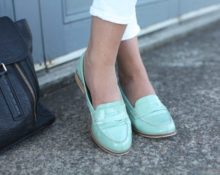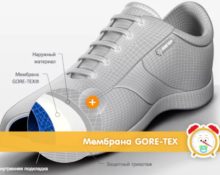Varicose veins are a disease that gets younger every year. If in the last century it mainly affected older people, now 30-year-old patients also come to the surgeon with this problem. Among the factors that provoke the development of the disease are uncomfortable shoes.
What shoes will be harmful?
There are many models on the shoe market for every season, taste and size. Unfortunately, not all of them are safe. You can recognize the “wrong” shoes by the following signs:
- a feeling of squeezing in one or several places - tight shoes compress the blood vessels;
- artificial material: it creates a greenhouse effect, disrupting water and heat exchange;
- a flat sole or, on the contrary, a heel that is too high fixes the foot in an unnatural position;
- a sole that is too thin will provide you with the opportunity to “enjoy” all the delights of off-road and injure your foot.
All these factors interferes with the flow of blood from the lower extremities. Constantly wearing such shoes can lead to foot diseases.
What shoes contribute to the appearance of varicose veins?
Women's shoes pose the greatest danger to veins. It is more diverse than men's. In addition, unlike men, who value convenience above all else, girls are often ready to sacrifice comfortto evoke the admiring glances of men and the envy of girlfriends, flaunting stunning trendy shoes from the new collection.
High heels
 They always look great on women's legs, visually making them slimmer and longer. The gait becomes elegant and graceful. But this type of shoe is fraught with great danger.
They always look great on women's legs, visually making them slimmer and longer. The gait becomes elegant and graceful. But this type of shoe is fraught with great danger.
The fact is that with a heel height of more than 7 cm, almost the entire load falls on the toe, and seals form on the foot under the toes - corns, and the ankle muscles are greatly stretched. The load on the veins increases many times, and the blood stagnates. Therefore, high-heeled shoes or sandals can be worn for a short time and not every day.
Shoes with very narrow toes
 Favorite classic “pumps” can also bring your feet to a deplorable state, if their nose is too narrow. The foot in this place is physiologically quite wide, and, “crowded”, the toes are in an unnatural position, and if there is even a small heel, they will be completely pinched.
Favorite classic “pumps” can also bring your feet to a deplorable state, if their nose is too narrow. The foot in this place is physiologically quite wide, and, “crowded”, the toes are in an unnatural position, and if there is even a small heel, they will be completely pinched.
In this case, the blood supply to the extremities practically stops, and inflammatory processes are initiated. Add friction to this, and you get a whole medical “bouquet”: calluses, numbness, swelling and even cramps.
Flat ballet shoes
These light and comfortable “slippers” have absolutely flat and extremely thin soles, without even a hint of a last that follows the curve of the foot. They, unfortunately, do not absorb movement or protect the foot in any way.
 Without any fastenings (elastic band, strap, zipper), they are held on the foot mainly by the fingers, which have to be strained (tucked in or, conversely, spread out) so as not to feel like Cinderella at the ball.
Without any fastenings (elastic band, strap, zipper), they are held on the foot mainly by the fingers, which have to be strained (tucked in or, conversely, spread out) so as not to feel like Cinderella at the ball.
The gait becomes “shuffling” and the fingers become deformed.. Another disadvantage of such a sole is the heel is lower than the rest of the foot, it accounts for the lion's share of the weight of the entire body. Because of this, the calf muscles are in endless, unpleasant tone, which also does not contribute to unimpeded blood flow.
Sports slip-ons
 Their main problem is the same as that of ballet shoes - flat sole. It greatly increases the risk of muscle strain, knee and tendon damage, and heel spurs. Reduce the danger a little Orthopedic insoles will help. These are closed shoes, so the temperature and humidity inside them are constantly increased, which causes a “thermos” effect and slows down the flow of venous blood. In addition, from prolonged stay in slip-ons, diaper rash and irritation appear on the legs.
Their main problem is the same as that of ballet shoes - flat sole. It greatly increases the risk of muscle strain, knee and tendon damage, and heel spurs. Reduce the danger a little Orthopedic insoles will help. These are closed shoes, so the temperature and humidity inside them are constantly increased, which causes a “thermos” effect and slows down the flow of venous blood. In addition, from prolonged stay in slip-ons, diaper rash and irritation appear on the legs.
Sandals with harnesses
 Open shoes with cross strap. Like a type of dog leash that wraps around the animal's chest instead of a neck and allows you to control its movements (hence its name - a harness), this strap more or less holds the sandals on the feet, but do not fix the heel and ankle.
Open shoes with cross strap. Like a type of dog leash that wraps around the animal's chest instead of a neck and allows you to control its movements (hence its name - a harness), this strap more or less holds the sandals on the feet, but do not fix the heel and ankle.
The danger of such shoes lies, first of all, in their instability.. Instability provokes loss of balance and the risk of twisting your leg and tearing ligaments. But that is not all. The legs are tense all the time, which interferes with the free circulation of blood.
Sandals with toes
 They differ from the previous model in that one of the strap elements passes between the first and second toes. As planned, this is the most sophisticated version of Soviet rubber beach “frogs”. To avoid chafing with a leather or plastic strap, you have to squeeze your fingers all the time. Because of this the leg muscles cannot relax, and the venous blood stagnates.
They differ from the previous model in that one of the strap elements passes between the first and second toes. As planned, this is the most sophisticated version of Soviet rubber beach “frogs”. To avoid chafing with a leather or plastic strap, you have to squeeze your fingers all the time. Because of this the leg muscles cannot relax, and the venous blood stagnates.
Clogs and mules
 Clogs are a type of sandals with a small wedge, made of cork or wood. Mules differ from them by having a heel instead of a platform. They are quite comfortable and stylish, they come with a closed toe, but more often with an open toe. Both of them have no backdrop at all, they dangle freely on the leg, and therefore pose an even greater dangerthan previous varieties of shoes.
Clogs are a type of sandals with a small wedge, made of cork or wood. Mules differ from them by having a heel instead of a platform. They are quite comfortable and stylish, they come with a closed toe, but more often with an open toe. Both of them have no backdrop at all, they dangle freely on the leg, and therefore pose an even greater dangerthan previous varieties of shoes.
What shoes provoke varicose veins in men?
 In the stronger half, varicose veins are much less common than in their beautiful companions. It is caused by any tight shoes, as well as models whose design prevents the uniform distribution of the load on the foot.. These include flip-flops, slip-ons and other sports shoes without heels.
In the stronger half, varicose veins are much less common than in their beautiful companions. It is caused by any tight shoes, as well as models whose design prevents the uniform distribution of the load on the foot.. These include flip-flops, slip-ons and other sports shoes without heels.
Our feet are exposed to enormous pressure every day. They need special care, so you should choose shoes, boots, and other footwear for each season even more carefully than clothes. When purchasing, it is important to evaluate not only beauty, but also quality. In the right shoes, your feet won’t get tired and your muscles won’t become very tense.. Otherwise, the normal functioning of the venous valves will be disrupted, the elasticity of the vessels will deteriorate, which will lead to sad consequences - progressive venous disease.


 0
0





